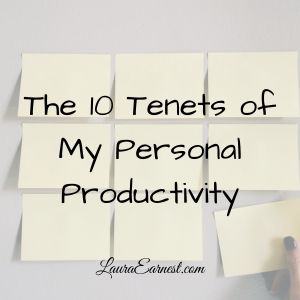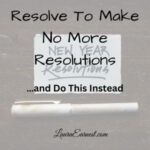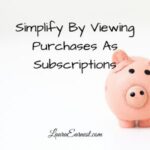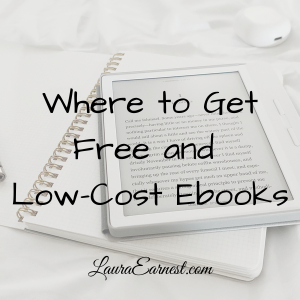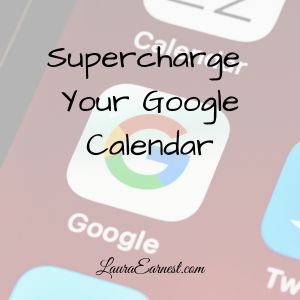A productivity system is only as good as the procedures that run it. A calendar may be a great tool but won’t function unless you remember to put appointments into it, and then check it regularly.
My 10 tenets help me use my tools for peak productivity.
Everything In Its Place
I believe that everything has a distinct place. This means that:
- Appointments (time/date events) go in the calendar (Google Calendar)
- Projects go into my project manager (Trello)
- Tasks go in the task manager (Remember The Milk)
- Notes go in a notebook (Paper notebook and OneNote)
- The iPad planner is used for planning my time, not for writing down things I hope may miraculously get done.
- Mail goes in my inbox, garbage goes in the can, recycling goes in the bin. Junk mail goes right into recycling.
These may seem obvious, but there are some systems that ask you to put your tasks on your calendar. Or store meeting notes in the meeting appointment on the calendar. Or everything goes in the notebook, and get put where they belong later.
When I keep things in their correct places, I don’t lose information.
Email Is A Processing Hub
This goes along with the previous item. Since everything is in its place, my email program is simply a box of bits that gets emptied out regularly. From that box, tasks get sent to the task manager, notes get sent to the notebook and appointments get sent to the calendar.
Working from the email inbox is, in my opinion, an inefficient way to do things because everything is jumbled together. You can’t get a clear picture of anything – not your notes, your tasks, your appointments or your overall load.
In addition, email is simply a way for people to push tasks onto you; if you don’t have a way to see them against your other tasks, you run the risk of always working on someone else’s priorities.
Everything In and Out Easily
I am a big fan of the easy button. If it isn’t easy, I’m not going to do it. To that end, it has to be easy to get information into the right places of my system.
If I want to enter an appointment, I can either put it directly in the calendar, or I can email myself the information.
If I want to enter a task, I can either use Remember The Milk directly, email myself the task, use a quick button on the phone (which emails the task), or as Siri to remind me to do the task. All of these things will end up in Remember The Milk.
If I want to take a note, I can write directly in OneNote, or I can write it in an app and send it to OneNote, or I can take a picture and send it to OneNote.
The same thing goes with pulling information out of the system. If I can’t get information out, there is no point in putting it in. So all of my options have the ability to be pulled out in multiple ways. I can pull my calendar into a spreadsheet, from which I can make a PDF for my planner. I can see my tasks, or have Remember the Milk remind me by alert, computer or text message. OneNote notes are tagged in every possible way to make it easy for me to find what I am looking for. I never have to struggle to find anything in the system.
Appointments on Cards
This is a personal rule that works well for me. All appointments that I make: doctor, dentist, hairdresser; they are all on paper cards. The reason is that I can’t input the information accurately and fast enough while I am standing at the desk. When I have the card, I can input it later, and make sure that the information is correct.
Obey the Laws of Time And Space
I am not a Time Lord (although sometimes I wish differently). So I am required to obey the laws of time and space.
In terms of productivity, that means that I am deliberate and reasonable about what I choose to do. If I have a day that is work followed by three hour-long appointments, I am not going to pick a dozen tasks to do that evening. If I have a wide-open day, I figure out what long-length tasks I will do, and then pick smaller tasks either in the same physical area or in the same vein. I also make sure that the total amount of work I expect to do on tasks does not exceed the time available.
I obey the laws of space by not carrying around excess stuff. I used to be really bad, carrying around everything I could possibly conceive of needing: multiple notebooks, tablets, computers, reading material, art supplies…. Now I carry my phone, keys and wallet, and my purse actually closes.
Inboxes Are Processed Fully
Every inbox I have is emptied at least once a day.
That means that all the physical mail gets dealt with every day, either by immediate action or by filing in the tickler.
It also means that my all of my email inboxes are cleared out at least once a day. Everything in there is either put in the calendar, sent to Remember the Milk, sent to OneNote, or filed for reference.
No exceptions.
Automate As Much As Possible
Systems work better if they don’t depend on human memory. The more automated my system, the more likely things end up where they are supposed to be.
I use my own programming to accomplish some of this: I have Google scripts that allow me to auto-archive and auto-delete mail; to send things to Remember The Milk by labeling them with a certain label; and filters in my email to do some of the reference filing automatically.
I also use a service called IFTTT that allows me to automate more. Articles I read in Instapaper, when added to a folder, automatically save to OneNote. If I get a notice from my Fitbit to charge, I add a task to Remember The Milk. With the Do buttons, I can quickly enter a note, task or calendar event.
I also rely on checklists in Remember The Milk as a self-automation tool. For things that I do regularly with multiple steps, I just have to follow along in Remember The Milk and I know I won’t forget anything.
Device Independent
All of my productivity has to be device independent. That means I have to be able to get to it from computer or phone or tablet.
I used to run all paper because of this, but I am always within reach of one of the devices above, and so I can access everything from everywhere. (What did we do before smart phones?!?!)
Accessible Where I Am
All of my information has to be accessible where I am. That means that if I am at the oceanfront, I can still check my appointments or write notes. If I am at the lake camping, I want to be able to see my craft patterns in OneNote or check my tasks.
Even if I don’t have internet connectivity, I still have to be able to get to the information. And even if it is a bit out of date, it will update when I get back into range.
The reason for this is to remove procrastination on tasks, and open up my schedule for fun. I used to not do fun things because I thought I didn’t have time. Now I can walk on the boardwalk even if I know I have an appointment later, because my system will remind me when I need to leave. It removes procrastination on tasks because they are always with me.
As Simple As Possible
The last part of my rules comes from my ongoing quest to simplify my life. I strive to simplify everything I can. The only difference is I am not interested in minimalism, and the simplicity and minimalism are often confused.
My productivity system has to be simple and straightforward with minimum doodads. In other words, I have to use tools that do not make me spend more time maintaining the system than in getting the work done.
The Tenets, Simplified
My 10 basic tenets for my productivity system are:
- Everything In Its Place
- Email Is A Processing Hub
- Everything In and Out Easily
- Appointments on Cards
- Obey the Laws of Time And Space
- Inboxes Are Processed Fully
- Automate As Much As Possible
- Device Independent
- Accessible Where I Am
- As Simple As Possible
In Conclusion
These ten tenets form the foundation of my productivity system, ensuring that I can manage my time and tasks effectively while maintaining simplicity and accessibility. By following these principles, I’ve created a reliable framework that adapts to my needs while keeping me organized and focused. The key is not just having the right tools, but using them in a way that enhances productivity rather than creating additional work.

